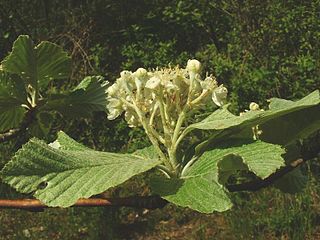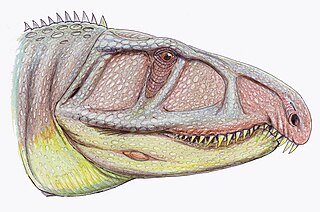Related Research Articles

The whitebeams are members of the family Rosaceae, comprising the genus Aria. They are deciduous trees with simple or lobed leaves, arranged alternately. They are related to the rowans, and many of the endemic restricted-range apomictic microspecies of whitebeam in Europe are thought to derive from hybrids between the common whitebeam and the European rowan. Some are also thought to be hybrids with the wild service tree, and the service tree of Fontainebleau found in French woodlands.

Dmitri Aleksandrovich Sennikov is a former Russian international association football defender best known for his performances for Lokomotiv Moscow, where he spent a total of 11 seasons.

Garjainia is an extinct genus of erythrosuchid archosauriform reptile from the Olenekian of Russia and South Africa. It was approximately 1.5–2 metres (4.9–6.6 ft) long. It contained two species, Garjainia prima from the Yarengian/Yarkenskian Supergorizont of Russia, and Garjainia madiba from the Burgersdorp Formation of South Africa. "Vjuskovia triplicostata", a name assigned to some erythrosuchid fossils from Russia, has been synonymized with Garjainia prima.

Sarmatosuchus is an extinct genus of archosauriform reptile found in sediments of Middle Triassic age and known from the single species Sarmatosuchus otschevi. It is one of the earliest stem-archosaur species known. The holotype and only specimen was found in lithified river deposits of the Donguz Formation exposed near the Berdyanka River, Orenburg region, Russia. The genus was originally included in the extinct family Proterosuchidae. However, later analysis by David Gower and Andrei Sennikov, the describing author, has removed it from the Proterosuchidae and designated it a basal archosauriform.
Dongusuchus is an extinct genus of archosaur. Fossils have been found from the Donguz Formation outcropping on the banks of the Donguz River in the Orenburg Oblast of Russia. They are associated with a fossil assemblage called the Eryosuchus Fauna, named after the capitosaurid Eryosuchus, the most common organism found from the assemblage. The locality dates back to the Anisian and early Ladinian stages of the Middle Triassic.
Jushatyria is an extinct genus of archosaur. Fossils have been found in the Koltaevo III Locality, district of Kumertau near the Ural Mountains in European Russia from the Bukobay Gorizont. The locality dates back to the Ladinian stage of the Middle Triassic. Additional material has been described from a locality on the banks of the Berdyanka River that was previously assigned to a rauisuchid-like archosaur. However, this material differed from the original specimens because it lacked slit-like antorbital openings accompanying the antorbital fossa. Nesbitt (2009) and Gower and Sennikov (2000) suggested that all material currently referred to Jushatyria most likely does not represent a single taxon. Thus, Jushatyria is known only from its holotype PIN 2867/5, an incomplete left maxilla. As the maxilla is damaged, many "rauisuchian" characters could not be verified. Jushatyria was reassigned as an indeterminate archosaur on the basis of the presence of an antorbital fossa on the lateral surface of the maxilla.
Tsylmosuchus is an extinct genus of proterosuchid archosauriform reptile known from Western Russia. Fossils referred to Tsylmosuchus occurred over a wide area in sediments corresponding to the Induan and Olenekian stages of the Early Triassic. Most of these fossils are fragmentary neck vertebrae which were originally reported as sharing similarities with crocodile-line archosaurs (pseudosuchians) such as Mandasuchus. As a result, Tsylmosuchus was first described as part of the family Rauisuchidae, making it supposedly one of the oldest known archosaurs. However, its fragmentary remains do not show any of the distinguishing features of rauisuchids or even pseudosuchians in general, so Tsylmosuchus has more recently been interpreted as an indeterminate archosauriform. Although three species of Tsylmosuchus have been named, they lack diagnostic traits and are probably not distinct from each other. In 2023, Tsylmosuchus was reinterpreted as a proterosuchid, specifically a member of the subfamily Chasmatosuchinae.
Vjushkovisaurus is an extinct genus of Middle Triassic archosauriform. It is known from the Anisian-aged Donguz Gorizont in Sol-Iletsk, Orenburg Oblast, Russia. The genus was named in 1982, with the type species being V. berdjanensis. Material has been collected in the Berdyanka II locality from a fossil assemblage called the Eryosuchus Fauna along the Berdyanka River, specifically in a sand-carbonate concretion in the upper part of the main river channel. Vjushkovisaurus is known only from the holotype PIN 2865/62, a partial postcranial skeleton which consists of 12 presacral vertebrae, left humerus, ribs, a fragment of the coracoid and a fragment of the fibula.
Collilongus is an extinct genus of small archosauriform, possibly a rauisuchian, known from Early Triassic rocks of Czatkowice 1, Poland. It was first named by Magdalena Borsuk−Białynicka; and Andriej G. Sennikov in 2009. The type and only known species is Collilongus rarus. It is a rare component of the Czatkowice 1 fauna, known only from vertebrae. Collilongus was a contemporary of the more common archosauriform Osmolskina.
Alexeyisaurus is an extinct genus of possible plesiosaur known from the upper Triassic of Wilczek Formation, Wilczek Land, of Franz Josef Land, Russia. It was first named by A. G. Sennikov and M. S. Arkhangelsky in 2010 and the type species is Alexeyisaurus karnoushenkoi. While considered an elasmosaur in the initial publication It has been described as a "partial, poorly preserved, and undiagnostic sauropterygian skeleton" in subsequent publications.
Vytshegdosuchus is an extinct genus of paracrocodylomorph archosaur known from the Early Triassic Yarenskian Gorizont of the Komi Republic of the European section of Russia. It contains a single species, Vytshegdosuchus zheshartensis. Vytshegdosuchus was named by Andreii Sennikov in 1988.

Protanystropheus is an extinct genus of archosauromorph from the Middle Triassic of Poland, Germany, Austria and the Netherlands. It was named by Sennikov in 2011 and the type species is Protanystropheus antiquus, first described in 1908 by German paleontologist Friedrich von Huene under the name Tanystropheus antiquus. Sennikov (2011) referred to Protanystropheus several vertebrae, including those belonging to "Thecodontosaurus" primus, but such a referral has later been questioned, because these specimens may represent other basal archosauromorphs.

Augustaburiania is an extinct genus of tanystropheid archosauromorph from the latest Early Triassic of Volgograd Region, western Russia. All specimens were recovered in the right slope of the Don River valley from the Lipovskaya Formation. It was named by Sennikov in 2011 and the type species is Augustaburiania vatagini. Augustaburiania is the oldest known tanystropheid.

Youngosuchus is an extinct genus of archosaur from the Middle Triassic of China. The type species is Y. sinensis. Y. sinensis was first described in 1973 as a new species of the erythrosuchid Vjushkovia. In 1985, it was reassigned as its own genus of rauisuchid. A 1992 study supported the original classification of Youngosuchus sinensis as an erythrosuchid, but more recent studies classify it as a "rauisuchian"-grade loricatan archosaur completely unrelated to Vjushkovia, which is most likely a synonym of Garjainia.
Vonhuenia is an extinct genus of proterosuchid, a basal archosauriform from the Early Triassic of Russia. Fossils have been found in the Vokhminskaya Formation, along the Vetluga River that are Induan in age, making Vonhuenia one of the earliest archosauriforms.

Eorasaurus is an extinct genus of archosauromorph reptile known from the middle late Permian of Tatarstan, European Russia. It contains a single species, Eorasaurus olsoni. When originally described by Sennikov (1997), Eorasaurus was identified as an early archosauromorph and assigned to the family Protorosauridae, Ezcurra et al. (2014) and Ezcurra (2016) later reclassified Eorasaurus and placed it within the group Archosauriformes. Eorasaurus is based solely on scant fossil material from the neck region, and is thus considered an unstable taxon in phylogenetic analyses. If Eorasaurus is an archosauriform, it would be the oldest known member of the group and would pre-date the previous record holder.

Uralosaurus is an extinct genus of erythrosuchid archosauriform known from the Middle Triassic Donguz Formation of southeastern European Russia. It contains a single species, Uralosaurus magnus. It was named by Vitalii Georgievich Ochev in 1980 as a species of Erythrosuchus otherwise known from the Triassic of Africa and reassigned to its own genus by Andrey G. Sennikov in 1995.
Doniceps is an extinct genus of reptile from the Early Triassic of European Russia known from the type species D. lipovensis. It was solely known from the holotype premaxilla 104/3106 housed at Saratov University, however the specimen is probably lost. It was collected at the Donskaya Luka Locality near the village of Sirotinskaya in Ilovlinsky District, Volgograd Oblast, from the Lipovskaya Formation of the Gamskii Horizon. The generic name refers to the nearby Don River added the Greek suffix for "head", -ceps. The specific name is derived from the name of the type locality Donskaya Luka, also known as Lipovaya Balka. Named by Otschev and Rykov in 1968 as an archosauromorph, Arkhangelskii & Sennikov (2008) classified the taxon as a possible trilophosaurid. Doniceps is thought to be similar to Coelodontognathus and Vitalia, both of which are known exclusively from the same locality and were first identified as procolophonids but later reclassified as trilophosaurids.
Vitalia is an extinct genus of reptile from the Early Triassic of European Russia known from the type species V. grata. It is known from the holotype dentary PIN 4173/126 as well as two additional dentaries PIN 1043/627 and 1043/628, all housed at the Paleontological Institute, Russian Academy of Sciences. The type dentary was originally included in the hypodigm of Coelodontognathus donensis named by the notable Russian vertebrate paleontologist Vitaliy Georgiyevich Ochev in 1967. Ivakhnenko (1973) separated the specimen and gave it its own genus and species name in light of the new material, which he named in honor of Ochev. The dentaries of Vitalia were collected at the Donskaya Luka Locality near the village of Sirotinskaya in Ilovlinsky District, Volgograd Oblast, from the Lipovskaya Formation of the Gamskii Horizon. Like Coelodontognathus, Vitalia was originally described as a procolophonid parareptile in 1973, but Arkhangelskii & Sennikov (2008) reclassified the taxon as a possible trilophosaurid archosauromorph. Vitalia is thought to be similar to the possible trilophosaurids Coelodontognathus and Doniceps, both of which are known exclusively from the same locality. Coelodontognathus and Vitalia are similar to procolophonids in that they have wide teeth but differs from them in that they have tooth roots set deep into the jaws.

Karpatiosorbus is a genus of flowering plants in the family Rosaceae, native to Europe, including Crimea, and Algeria. Shrubs or small trees, they appear to have arisen via hybridization events between the clades Aria(Pers.) Host and TorminalisMedik. Many of its species propagate solely by apomixis.
References
- ↑ "Yevgeny Sennikov". Olympedia. Retrieved 8 July 2020.